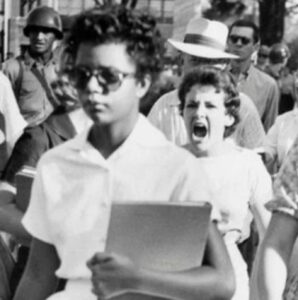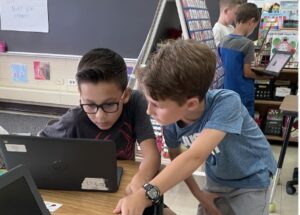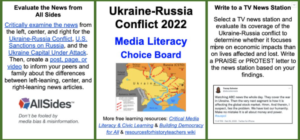Not Your Parents’ History Class
Bueller? Bueller? The image of Ben Stein’s sleepy-headed, gum-popping history students in the 80’s classic Ferris Bueller’s Day Off is probably not far from the history class adults experienced in their own high schools across America during the last few decades of the 20th century. Given this, it is no surprise that parents of today’s teenagers may believe their child’s history class experience would mimic their own. However, the technology explosion, shifts in pedagogical approaches, changes in historical interpretation, and the increase in the number of students moving on to post-secondary education have caused twenty-first century history classrooms to look very different from years past. Here is a breakdown of the differences between their parents’ history class and the history class of today’s high schoolers.
THEN: NO STATE STANDARDS
NOW: STANDARDS-BASED INSTRUCTION
Prior to the 1983 seminal and controversial report A Nation at Risk, standards were not, well, standard. The State of New Jersey, where I spent twenty years of my career, had no academic learning standards until 1996, which resulted in content being left up to the schools. Content from classroom to classroom may have differed dramatically depending on the content preferences of teachers and interests of the students, especially in non-tested areas like Social Studies. The adoption of standards narrowed down the focus of history instruction to a set of standards that all schools and teachers were required to follow. This affected what was taught in the classroom and gave individual teachers a collective roadmap to follow when planning instruction and assessment.
THEN: CONTENT-BASED CURRICULUM
NOW: SKILLS-BASED CURRICULUM
While parents’ history classes were primarily content-based, focusing largely on the recall of facts and retrieval of information, today’s history classes are skills-based, which focus more on the development of skills that will benefit students in college and career. These skills include reading, writing, speaking, and listening– more commonly known as literacy skills– as well as historical thinking skills. Today’s teachers utilize tools such as Webb’s Depth of Knowledge to create lessons and assessments that require students to apply a range of thinking skills, from basic recall to the synthesis of information from multiple sources. An outcome of this approach has been the incorporation of assessments that had historically been reserved for higher-level AP classes into all history classrooms. The recall writing that was common in classrooms of the past has now been replaced with analytical writing tasks, such as the DBQ (document-based question), which had historically been the hallmark of AP classes. Incorporating higher order thinking into all history classrooms has elevated instruction and assessment to better prepare students for life after high school.
THEN: DATES AND NAMES
NOW: HISTORICAL THINKING SKILLS
Anyone who took a high school history class more than 20 years ago can probably recall asking the teacher “will we have to know dates?” And, the answer was most likely “Yes.” This method resulted in kids with great memories getting the A’s and kids with not-so-great memories struggling. In today’s classroom, teachers are more focused on teaching students historical thinking skills rather than simply a timeline of events. Historical thinking skills allow students to develop a more comprehensive understanding of historical themes. They help students analyze rather than simply describe historical events, explore multiple perspectives, and make connections between events past and present. The deliberate comparison of historical events to current events help students see the relevance of history to their lives today.
THEN: ACCEPTING HISTORY AS A SET OF FACTS
NOW: TEACHING HISTORICAL INQUIRY
History instruction of the past largely consisted of a series of historical events presented to students one after the other. In the past, history students accepted the facts as presented by their teachers or history books and were assessed solely on their recall of the facts. The facts, often presented from a single perspective drawn exclusively from secondary sources, were the focus of the lessons. This method has changed in recent years. Today, historical events are presented and analyzed from multiple perspectives through primary sources in order to give students firsthand accounts of the event. Viewing a historical event from the perspective of different groups allows students to have a more nuanced understanding of the event and its consequences.
A common approach to teaching and learning in today’s history classrooms is the inquiry model. Through this model, students investigate a historical question by utilizing the techniques used by historians to evaluate multiple perspectives and make claims supported by credible evidence. This model is used by teachers to explore perspectives on historical figures, such as Christopher Columbus. In classrooms of the past, certain historical figures were presented from a single perspective, leaving no room for students to deliberate on the legacy of those figures. In today’s classroom, legacy is one of those topics that is ripe for use with the inquiry model where students can examine multiple perspectives and evaluate claims and evidence to come to their own conclusions about the impact of historical figures and events.
THEN: BOOK RESEARCH
NOW: DIGITAL RESEARCH
Anyone who went to school before the Internet remembers spending hours in a dusty library combing through books and feeding nickels into a copy machine. The Internet and digitization of information changed the entire research process, leading to the need to teach students digital research skills. In addition to teaching digital research skills, teachers today focus on equipping students with the skills needed to evaluate all sources for validity and credibility. The evaluation of sources, both digital and print, is a necessary historical research skill that adds to a student’s ability to form a more comprehensive understanding of history as well as a way to manage the overflow of misinformation that is present all around them.
While many aspects of history education have changed over the past several decades, there are still constants. So, what hasn’t changed in history classrooms?
Great teachers!
Regardless of approach, pedagogy, instructional models and new research, great teachers have always existed. These are the teachers who make even the most mundane content come to life, the teachers who have classrooms full of engaged learners. They make connections with students, invest in their students’ well being inside and outside the classroom, and making learning easy. Great teachers have always existed and will always exist.
Changing approaches to teaching history.
With new research, the increased accessibility of information, and school districts’ commitment to professional learning, the approaches to teaching and learning – – in all subject areas- – will undoubtedly change as we creep further into the 21st century. While history teachers focus largely on events of the past, their strategies used to teach these events will continue to develop into the future.








Thanks Melissa- What a great summary of the changes in history instruction over the last 20 years! I clearly recall my freshman history teacher telling my folks during parent/teacher night that “some subjects are just boring but we still had to learn them.” He was a great cross-country coach. Not so much in the classroom!
And I compare that to some of the sophisticated ways our colleagues are teaching now and kind of envy the way todays students are engaged in complex analysis and inquiry.
Thanks again!